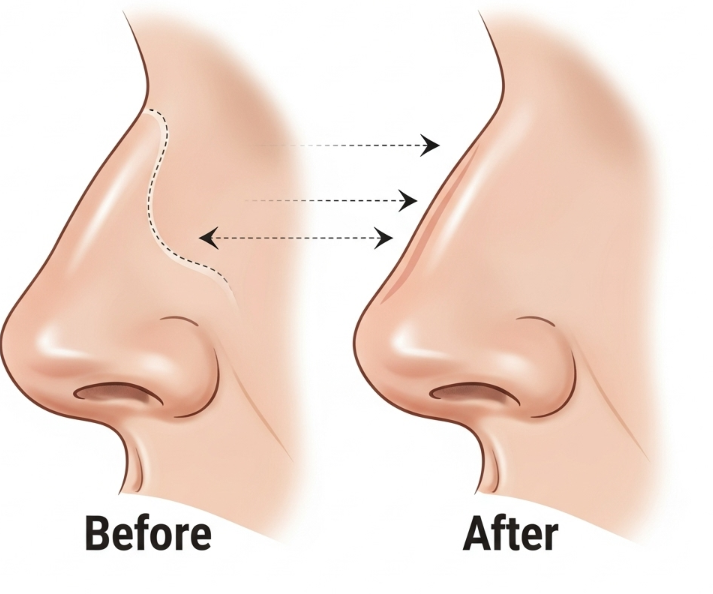Treatment Overview
Deviated Septum Closed Rhinoplasty in Korea is a minimally invasive procedure aimed at correcting septal deviation while simultaneously refining the nasal structure. Performed entirely through internal incisions inside the nostrils, this technique leaves no visible scars and improves both nasal function and facial aesthetics. Korean surgeons are internationally recognized for combining functional correction with natural-looking results using advanced closed rhinoplasty techniques.
Purpose & Benefits
- Corrects nasal obstruction and breathing difficulties caused by septal deviation.
- Improves airflow, reduces snoring, and alleviates sinus issues.
- Enhances nasal symmetry and overall facial balance.
- Scarless procedure with minimal downtime.
- Can be combined with tip or bridge refinement for aesthetic improvement.
- Shorter recovery and less postoperative swelling compared to open rhinoplasty.
Ideal Candidates
- Individuals with difficulty breathing through the nose due to deviated septum.
- Patients with crooked or asymmetrical noses caused by septal misalignment.
- Men and women seeking scarless internal correction.
- Candidates with recurrent sinus infections, snoring, or sleep apnea.
- Those requiring primary or minor revision functional rhinoplasty.
Possible Risks & Complications
- Temporary swelling, bruising, or mild discomfort.
- Rare risk of septal perforation or cartilage shifting.
- Minor asymmetry in nasal structure.
- Infection or internal scarring (extremely rare).
- Possibility of revision surgery if deviation recurs or airflow is not fully corrected.
Surgical Techniques Used
- Closed Internal Incisions: All incisions made inside the nostrils for a scarless approach.
- Septoplasty: Straightening and repositioning of the deviated septum.
- Cartilage Trimming & Grafting (if needed): Reinforces weak or crooked areas.
- Tip & Bridge Refinement (optional): Minor adjustments to maintain balance and aesthetics.
- Spreader Grafts or Functional Support Grafts: Used to stabilize nasal valves and improve breathing.
Recovery & Aftercare
- Downtime: 7–10 days for swelling and bruising to subside.
- Stitches: Absorbable and internal, leaving no visible scars.
- Postoperative care in Korea includes:
- Swelling reduction therapies (laser, ultrasound)
- Nasal irrigation and cleaning guidance
- Regular follow-up visits to monitor septum alignment and breathing
- Support from English-speaking coordinators for international patients
Results & Longevity
- Permanent correction of septal deviation.
- Significant improvement in nasal airflow and breathing.
- Symmetrical and natural-looking nasal appearance.
- Reduced snoring and sinus-related issues.
- Long-lasting results with proper post-op care and cartilage support.
Treatment Process in Korea
- Consultation & 3D Imaging:
- Comprehensive evaluation of septal deviation and nasal structure.
- Customized plan for both functional correction and aesthetic refinement.
- Preoperative Assessment:
- Blood tests, nasal endoscopy, and airway evaluation.
- Selection of grafts if needed to reinforce weak septum or nasal valves.
- Closed Deviated Septum Rhinoplasty Procedure:
- Performed under general anesthesia.
- Internal incisions provide access to the septum without external scars.
- Deviated cartilage and bone repositioned, trimmed, or grafted as needed.
- Optional tip or bridge refinement for natural facial balance.
- Immediate Postoperative Care:
- Soft internal splints or packing may be used to stabilize the septum.
- Short-term observation in the clinic for 1–2 days if necessary.
- Follow-Up & Aftercare:
- Swelling reduction treatments and routine monitoring.
- Endoscopic checks to ensure proper septal alignment.
- Remote consultation for international patients.
Why Korea is a Top Destination:
- Surgeons specialize in scarless functional rhinoplasty with precise septal correction.
- Advanced closed techniques reduce risks, minimize swelling, and provide faster recovery.
- Clinics offer comprehensive aftercare, translation services, and patient support for international visitors.
Cost Range
- Basic closed deviated septum correction: ₩3,500,000 – ₩5,500,000 KRW ($2,700 – $4,200 USD)
- Closed septum rhinoplasty with tip/bridge refinement: ₩6,000,000 – ₩8,500,000 KRW ($4,600 – $6,500 USD)
- Complex or revision cases with cartilage grafting: ₩9,000,000 – ₩12,000,000 KRW ($6,900 – $9,200 USD)
Packages typically include:
- Surgeon and anesthesia fees
- Operating room & hospital charges
- Postoperative swelling reduction therapy
- English/Chinese interpreter and patient support services
Popular Clinics in Korea
- ID Hospital (Seoul): Expert in closed septal correction with natural results.
- Banobagi Plastic Surgery (Seoul): Specializes in scarless functional rhinoplasty.
- JW Plastic Surgery (Seoul): Advanced cartilage grafting for septal stability.
- View Plastic Surgery (Seoul): Trusted for precise closed functional and cosmetic correction.
- The PLUS Plastic Surgery (Seoul): Internationally recommended for closed septal rhinoplasty.




